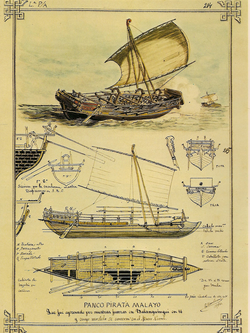Garay (ship)

Garay were traditional native
History

Most garay were built in the shipyards of
Description
Garay were smaller, faster, and more maneuverable than the Iranun

They were also propelled by
The largest garay were around 70 to 80 ft (21 to 24 m) long and could carry up to 80 men, but most garay averaged at 60 to 70 ft (18 to 21 m) with around 60 men. Even smaller garay also existed with an average crew (sakay) of 25 to 30 men.
Garay were led by a nakura or nakuda (commander) who in turn is led by a squadron leader, the panglima. The julmuri (
Garay did not possess
Role
Garay were lightly armed, in comparison to the lanong. They usually only had a single large cannon (lela). While the lanong specialized in ship-to-ship combat, the garay was more suited to raiding coastal villages and attacking unarmed or lightly armed trade ships.[2]
See also
- Spanish expedition to Balanguingui
- Lepa (ship)
- Balangay
- Kora kora
- History of slavery in the Muslim world
References
- ^ James Francis Warren (1985). "The Prahus of the Sulu Zone" (PDF). Brunei Museum Journal. 6: 42–45.
- ^ ISBN 9789971692421.
- ^ a b Yule, Henry & Burnell, Arthur Coke (1886). Hobson-Jobson: Being a Glossary of Anglo-Indian Colloquial Words and Phrases and of Kindred Terms Etymological, Historical, Geographical and Discursive. John Murray. p. 509.
{{cite book}}: CS1 maint: multiple names: authors list (link) - ^ Ricardo E. Galang (1941). "Types of Watercraft in the Philippines". The Philippine Journal of Science. 75 (3): 291–306.
- ISBN 9789814311960.





